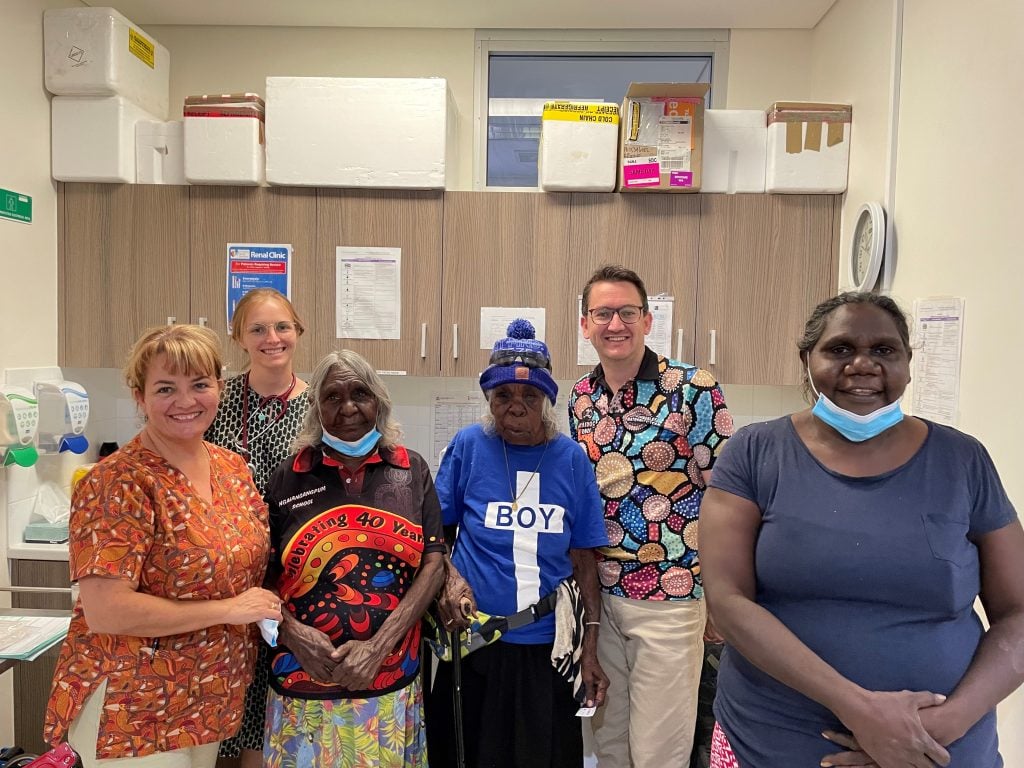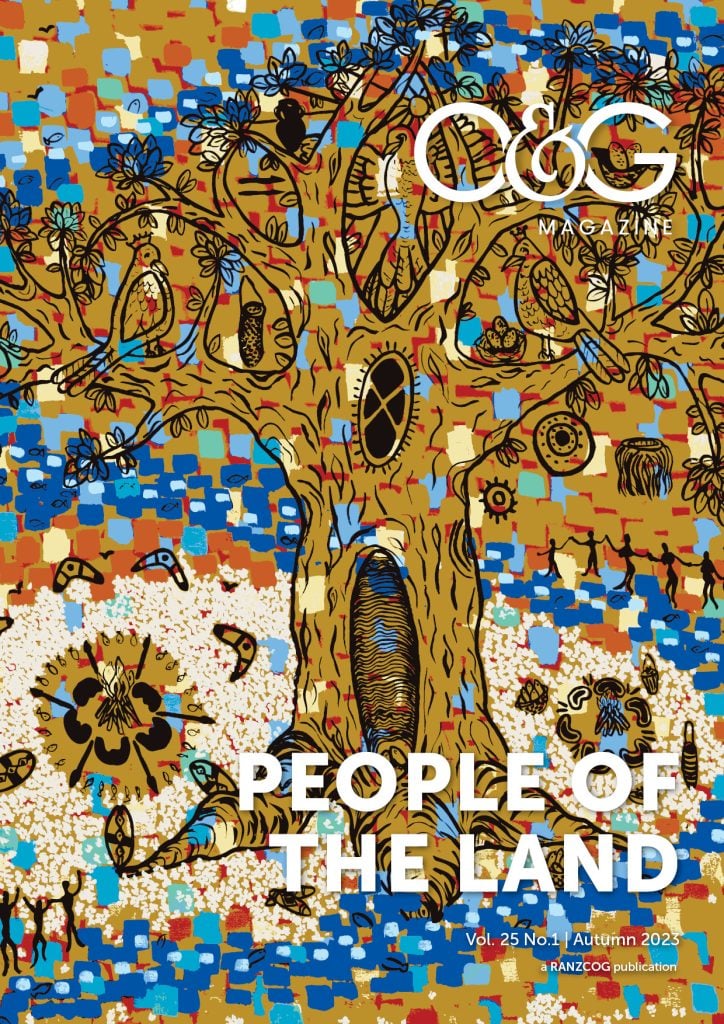She sat across from me with her eyes looking down. “Any problems with your pap smears or cervical screening?” I asked. She did not say anything back. It was another hot, Kimberley wet-season day and through the clinic window, I could see thunderstorm clouds starting to brew on the horizon. I was sure the pilot was watching them closely.
“Any problems with your periods or your bleeding?” I tried again. She remained quiet, only glancing at me for a few seconds, somewhat warily, out of the corner of her eye.
We were sitting in a small consult room in a remote clinic on the Western Australia border. I had been working in the Kimberley for a couple of years and had started taking on more remote work. That morning, I had driven for a couple of hours, crossed flooded rivers and experienced the tropical weather up close with a very bumpy small plane ride into the community.
I suspected that the patient had travelled about the same distance. She was on my list to be seen as a gynae patient, but I could not find any referral details. With three electronic medical record systems, as well as paper notes, it can be a struggle.
“Do you have any children?” I tried. “Do you want any more children?” I wondered if this was a referral for fertility, or maybe contraception. She shrugged again.
Looking at her, I suspected she might be in her early forties. Her birthdate was the 1st of July, which may have meant she was born ‘outbush’, and her exact age was not known. She was a thin Aboriginal woman who I presumed had lived exclusively in her remote community where there were only a few houses and families.
Getting nowhere, and knowing that English was likely her fifth language, I tried the local word for urine. “Any problems with your goomboo?” No luck, she remained silent.
After 15 minutes of flicking through paper notes and computer screens, I was no closer to working out why she was on the list to be seen. I started to wonder if the lack of engagement was down to me being a male. From knowing where she lived, I suspected that she held very traditional Indigenous cultural values regarding ‘women’s business’, where such things are not discussed in the presence of males.
I tried again with a general question. “Do you have any women’s business problems? Any secret women’s business?” For the first time she looked up at me. I was still expecting a short, negative answer when she asked, “You Lady Doctor Jared?” Slightly stunned and somewhat surprised by her answer I replied, “Oh, um, okay, yeah, um, I guess I’m Lady Doctor Jared,” also missing the ‘s’ in my answer.
“Oh, I heard about you. You’ve seen my cousin,” she replied. “You come from Broome, Yawuru Country. My cousin says you’re okay.” While still stunned, I was thankful that I had previously learned that being “okay” in Aboriginal language was actually “pretty good”. Otherwise, I would be very worried about my reputation around town! And with that, she continued talking for 15 minutes straight, telling me all about her “secret women’s problems.” She was then happy for an examination and thankfully Lady Doctor Jared was able to help her with the problem.
A couple of hours later the pilot phoned the clinic and reported that we needed to head off early as storms were coming. As we were heading to the airstrip, I relayed the story to the Aboriginal Health Worker who was driving us. I had known the Aboriginal Health Worker since I was a medical student in Broome. She laughed and told me about the sign in the local store that said: “Lady Doctor here every first Tuesday.” That was how I was talked about around the community.
I was somewhat amused and confused as the Aboriginal Health Worker continued. “Remember your first clinic here when only one patient turned up?” I did. While it had been over a year since that clinic, I remembered being mortified when only one out of 24 patients arrived. The clinic staff had kindly reassured me that it was likely due to the weather, or a funeral in another town.
“Well actually, the women did know there was a young new male doctor coming,” the Aboriginal Health Worker told me. “So they sent one woman to check you out. She reported back that you were ‘okay’ and thanks to her, your clinics have been busy since.” I was stunned silent again, reflecting on what could have been if I had got that consultation wrong!
The Aboriginal Health Worker laughed, probably reading my face. “Don’t worry, remember we taught you well as a medical student back in Broome.” I also laughed, remembering our time together with her trying to teach me how to take bloods, dispense drugs and do dressings. But then I realised she was referring to the most important lessons her and other Aboriginal doctors, midwives and health workers had taught me regarding cultural safety.
The Aboriginal Health Worker replied, “But think about today’s consultation and what worked to get the woman to talk to you.” I was not sure what she meant, so she continued. “It was once she worked out who you were that you both found a common connection and she knew a bit about you. Then she felt safe and secure, and could tell you about her problems through yarning.”
Finally, it started to click. It was the mutual connections, shared relationships, patience, and non-verbal language that had been so vital in ensuring patient-centred care and cultural safety. But it had taken some time to get to this point and it was actually the patient who had done most of the work to ensure the consultation was culturally safe for her.
Embarrassed by this realisation, I decided that I needed to work on this and gain further guidance from other Aboriginal staff and patients on how to improve these vital skills.
Fives years on, I continue to learn every day, to help ensure the care I provide, and the health services I work in, are more culturally safe. The name, Lady Doctor Jared, has also stuck and is proudly on the door when I visit that clinic!

Warmun community medical team and patients (L-R): Dr. Catherine Engelke, Dr. Claire Eatwell, Eileen Bray,
Mabel Juli, Dr. Jared Watts and Leanne Mosquito.
The following is a summary of what I have learnt from my patients and colleagues from working as a cis male in the Kimberley. However, I acknowledge the diversity of all people, in particular within the Aboriginal population right across Australia, and that I still have a lot to learn myself.
1. Cultural safety is everyone’s business
It could be argued that the gold standard of providing culturally safe obstetric and gynaecological care for Aboriginal women is to have only female healthcare providers. However, we know this is likely not possible and we may cause harm by not teaching and training male doctors in this area.
For example, while the O&G speciality workforce is now predominantly female, there is still a predominance of male Fellows and Diplomates in rural and remote areas with higher percentages of Aboriginal people. With often thousands of kilometres between health services, we need to ensure that all O&G doctors, regardless of their gender, have skills and training in cultural safety, to ensure Aboriginal women feel comfortable and safe to access their local service.
There is also evidence of Aboriginal women presenting to emergency departments or primary care providers, where they are seen by a male clinician who does not enquire about gynaecological symptoms, or offer an examination if required. Without appropriate training and experience, these doctors may feel they do not have the skills to ask such questions in a culturally sensitive and safe way. The patient may not volunteer or disclose these symptoms if they do not feel culturally safe. This can lead to harm through a delay in diagnosis and treatment for these Aboriginal women.
2. Relationships
For many Aboriginal people, relationships and personal connections are central to wellbeing. This includes both connections to other people, as well as to their land. I have learned that finding a connection and sharing a part of who you are is essential in creating trust. In my consultations, I try to do this early through asking where the person has travelled from (their land) and who their community is (their mob). I share where I have come from that day, and which Aboriginal land I grew up on.
Regarding shared connections, I am lucky that I know most of the GPs that refer patients. I always lead with this information. For example: “Oh your GP, Doctor Chevaun, sent you to see me. I know her.” Finding these mutual contacts and sharing about myself can quickly give us a connection, and we then have a basis to start talking about personal issues more easily.
3. Language
Noting the traditional difficulties in speaking about women’s health with a male, I often use local language for certain terms. I am not sure if it is the local words, or the patient laughing at my bad pronunciation, but this further opens discussions. I feel it may also show that I have been around for a while and have a connection to the community.
Personally, I have tried to use local interpreters but without great success, as many remote languages are spoken by only a small number of people who are often known or related to the patient. So instead, I find using a local nurse or doctor who can speak more of the language can assist in smaller communities.
4. Non-verbal language
An understanding of local non-verbal customs is also important to ensure cultural safety. In the Kimberley, this can include not making eye contact as a sign of respect. I often sit side-on to the patient during consultations and watch their body language to see how they are reacting.
5. Appropriate chaperones
As a male, at times I have found having a female in the room for the whole consultation can create a more relaxed environment. I may speak to the patient, but they then feel more comfortable to address their replies to the female. As with all my patients, having a female in the room for an examination is essential, but it must be someone culturally appropriate. Once again, the Aboriginal Health Worker or nurse in the community might be a relation, and therefore not appropriate for them to be involved.
6. Patience and yarning
In medicine, we are told that often we interrupt the patient within 11 seconds of them starting to talk1 and this delays us getting to the correct diagnosis. I have found listening and not interrupting is even more essential in Aboriginal health. It is important to let the patient tell their story through yarning, to allow them to ‘check you out’, develop trust and then tell you the reasons they are there.
7. Privacy and shame
In all aspects of medicine, we need to ensure confidentiality, and this is essential in Aboriginal health. For gynaecology, I have learned that when asking patient to do a self-obtained low vaginal swab (SOLVS) or mid-stream specimen of urine (MSU), it is important that when they walk back to the clinic room, that swabs or containers are not seen by others, particularly males. In recalling patients for results, especially in gynaecology, it must also be done in such a way to avoid singling out an individual, which can lead to shame.
Finally, it takes time and effort to build relationships and earn trust. Recently, I was working alongside a female doctor in a remote community. She was about the same age as me but was somewhat new to the area. I noticed the next patient was an elderly Aboriginal woman, and upon reading the referral, I thought she might find it more acceptable to see the female doctor.
Seeing me put her file into the other doctor’s box, the patient got angry with me, pointing out she was next. I offered the explanation that she might want to see the female doctor and I received an even bigger telling off. She scolded, “I remember you as a medical student when you came here with Doctor Cherelle. We taught you all about women’s business then. I know you have also delivered my grandson, so don’t be lazy and you be my doctor.”
Feeling both honoured and reprimanded all at once, I quickly hurried her into my clinic room. But she had not finished with me yet. With a huge grin and smirk, she added, “Plus you too pale to be a real man anyway.”
Our feature articles represent the views of our authors and do not necessarily represent the views of the Royal Australian and New Zealand College of Obstetricians and Gynaecologists (RANZCOG), who publish O&G Magazine. While we make every effort to ensure that the information we share is accurate, we welcome any comments, suggestions or correction of errors in our comments section below, or by emailing the editor at OGmag@ranzcog.edu.au. Those pictured have provided consent for their name and image to be included.






Leave a Reply